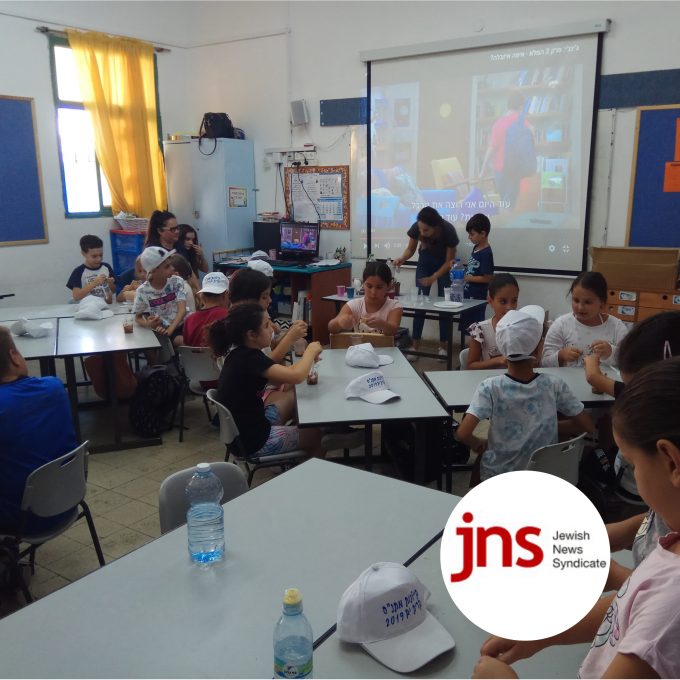ORT Argentina’s schools are providing an exciting vision of the future for a group of visiting students and teachers from CIM-ORT school in Mexico City. Eleven teenagers and two teachers, together with CIM-ORT’s Co-ordinator of Academic Outreach, Amelie Esquenazi, are in Buenos Aires for a 10-day tour for ideas, advice, insights and inspiration that will help them build on their own “�learning by doing’ pedagogical model.
An intensive program has the students participating in classes and their teachers enjoying training seminars covering the strategic adoption of educational technology, the creation and implementation of technology-enriched lessons, and the integration of “リdigital competence’ in the curriculum.
“We have been doing this for a long time so we have a lot of experience to share,”? said Jimena Castellion, Head of Teacher Training at CREA, ORT Argentina’s Teaching and Learning Resources Centre, who assisted Educational Director Viviana Jasid in organising the Mexicans’ visit. “But we also benefit: this is an exchange of experience, we both grow and learn; it’s not just us giving advice.”?
Since taking the helm at CIM-ORT soon after it joined the ORT network in 2010, Kalya Hilu has introduced project-based learning for the school’s 650 students from kindergarten all the way through high school.
“The rationale for this is that students do not learn by being passive recipients; they learn through doing. Case studies are a good way of training students to ask questions, to investigate and to learn independently,”? said Ms Hilu.
Similarly, ORT Argentina places students at the centre of the learning process, giving its 8,000-plus students tasks which they address by being collaborative and drawing on skills and information from across the curriculum.
Its Pedagogical Model 2.0 won ORT Argentina the Hewlett Packard EduInnovator People’s Choice Award at the International Society of Technology in Education (ISTE) world conference in Philadelphia two years ago. The 2.0 model enhances the development of e-competencies such as critical and inventive thinking, information and communication skills, and problem-solving skills; teachers develop their own virtual educational material which is published on ORT Argentina’s Virtual Campus that students (and their parents) can access at school and at home. Each class has its own on-line social space so students can discuss what they are learning and share material with each other and their teachers.
“It’s not just teachers explaining things, it’s teachers as facilitators, enabling students to try things for themselves, not just what the teachers want them to do,”? said Ms Castellion.
It has made a huge impression on the CIM-ORT students. One of them, Nurit Becker, 16, has enjoyed the classes as much as the variety of cultural and recreational activities organised for the visitors.
“It makes me feel great because at our school we are on our way but here they have it. Being here is like seeing what our school will be like in a few years because we know it really works,”? she said.
While schoolmate Alexa Bronzwaig has declared proudly that she is now “100 per cent ORT”?.
The Mexican and Argentinian students were quickly working together “like they’ve known each other for years”?, said Ms Esquenazi. “You have no idea how wonderful and easy it has been.”?
The experience is making her think of the future, too. “The impact I hope this will have on our school is that it will make our students feel that CIM-ORT is the school that they would want their children to attend because they’ll see that we prepare them for university and for a better life.”?
It is intended that the Mexicans’ visit will be a platform for closer collaboration between the two institutions, including further teacher training conducted both virtually and face to face.
Such cross-border visits and collaboration have long been characteristics of World ORT’s global network, a notable example being the fruitful relationship between the fashion design departments at ORT Strasbourg and Moscow ORT Technology College. Since joining the ORT network, CIM-ORT has embraced the opportunities available: they have hosted and its educators have attended Latin America’s regional World ORT Naomi Prawer Kadar International Seminars for Digital Technology in Jewish Education and before them the Terry and Jean de Gunzburg Jewish Education Seminar series. Its teachers have also joined staff from other ORT schools in London for the Hatter and Wingate Seminars, and students have taken the trip to participate in World ORT’s English and Science Summer School.
And its IT teachers on the Buenos Aires mission, Luis Perez and Isaac Cerrillo, have been involved in their school’s participation in the World ORT iJET Challenge. Sponsored by the L.A. Pincus fund for Jewish Education in the Diaspora, the Challenge has teams from ORT schools around the world produce blogs in which they describe and interpret the life and times of one of 12 great figures from Jewish history through that person’s eyes.
“It’s a privilege to be part of the World ORT network of schools that have all these wonderful things to share and a willingness to do it,”? Ms Esquenazi said. “People don’t always want to share what they have but here at ORT Argentina we’ve found every door open and every person with a smile and a nice word “モ and the desire to share everything they know. This is what World ORT is all about.”?
World ORT’s Education Department is working to increase the number of CIM-ORT-style missions by matching schools.
“We are talking about pockets of excellence “モ schools that have particular strengths “モ and choosing two schools with different strengths to learn from each other,”? said the Department’s Head, Daniel Tysman. “We’re certain that the relationships made during face-to-face meetings between teachers and students will result in long term educational partnership and collaborative working for the benefit of all involved.”?





